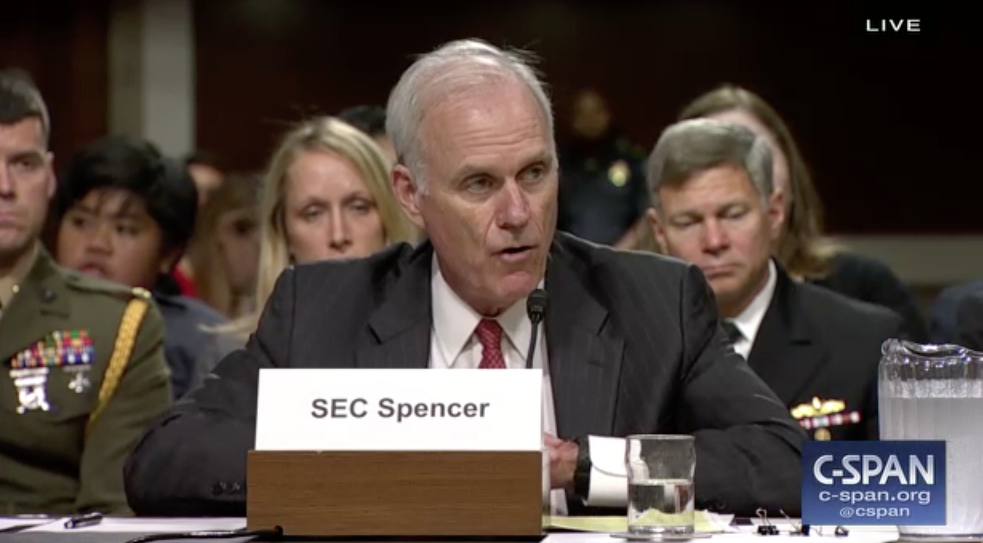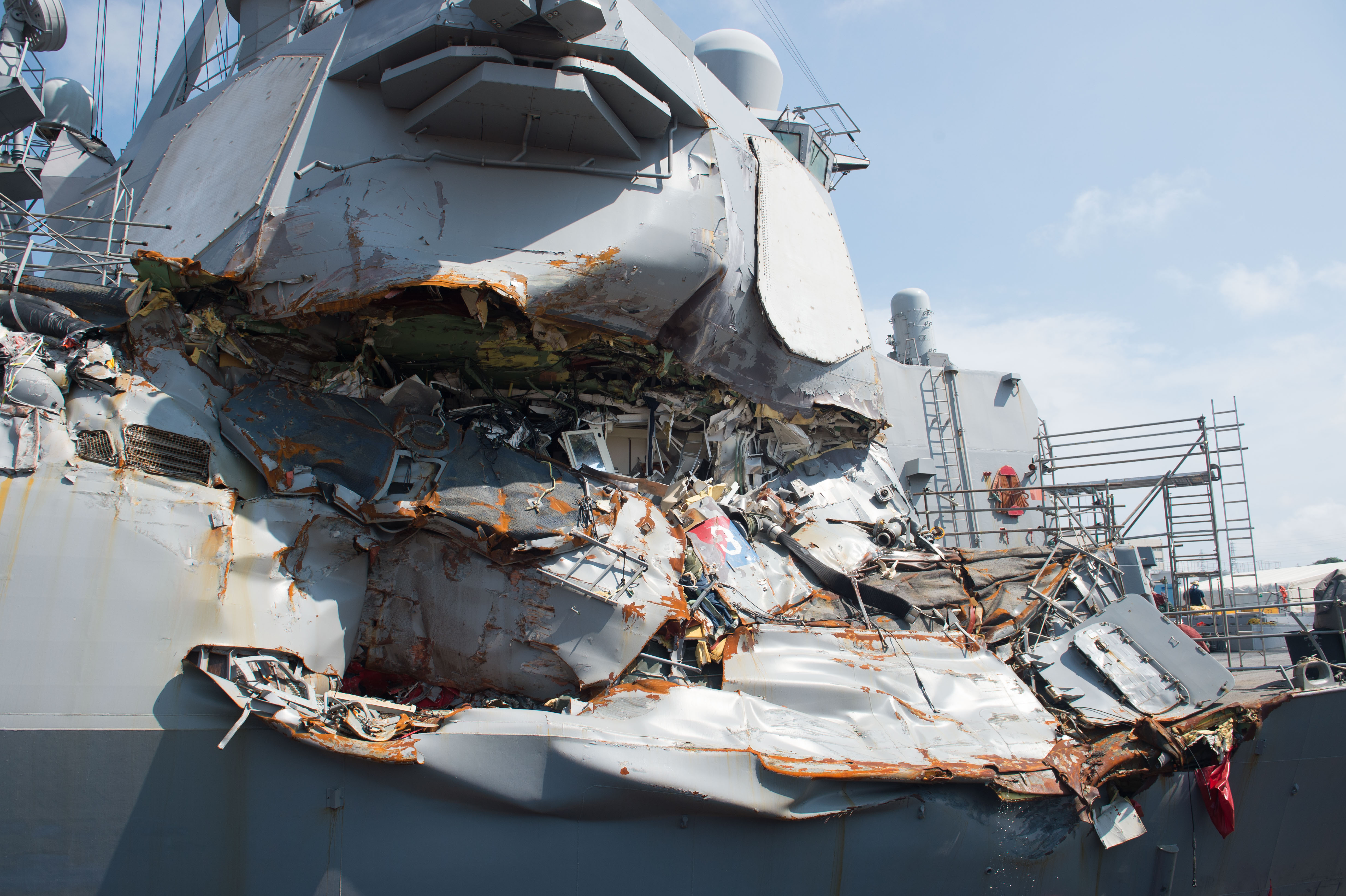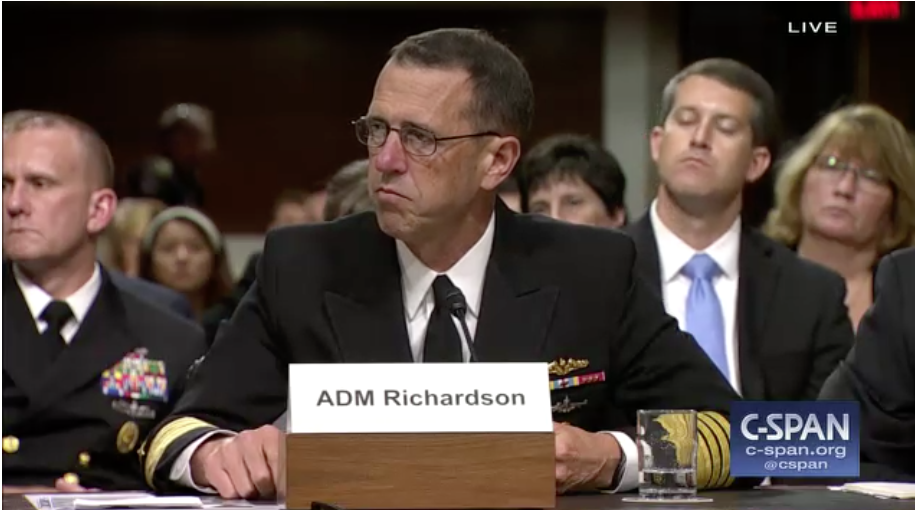
CAPITOL HILL – Secretary of the Navy Richard V. Spencer’s strategic study in the wake of two deadly collisions at sea this year intends to question everything the Navy does – how missions are tasked to ships, whether the service still needs its five numbered fleets, the relationship between the East Coast and West Coast fleets, and more – the secretary told USNI News today after testifying to the Senate Armed Services Committee.
Spencer described three ongoing efforts in the aftermath of the fatal USS Fitzgerald (DDG-62) and USS John S. McCain (DDG-56) collisions this year: near-term actions, such as going hull by hull to determine material readiness, immediate training on radar plot, and other actions recently implemented by the fleet; a chief of naval operations-directed study on the “tactical workings of how we operate the forward fleet;” and Spencer’s strategic study.
Spencer tapped Defense Business Board chairman Michael Bayer and former chief of naval operations retired Adm. Gary Roughead to lead his study, and eight companies have so far joined in the effort – BP North America, the Mayo Clinic, Crowley Marine, Delta, Maersk and Boeing, among them – “to have different points of view but from people who have lived through the exact same thing: cathartic or meaningful events and they’ve adjusted their culture to come out the other side a higher-operating, higher-impact organization.”
“I’m going to be focusing on how we’re tasked – the root causes of the fact that [combatant commanders] turn around and give us a full slate when we’re going to fill 47 percent,” he told USNI News, referring to the Navy’s ability to fulfill COCOM requests for Navy ship presence.
“Let’s question how they’re tasking us. Let’s question what the fleet laydown should be to the threat. If we go back to history, one of the reasons we have five fleets in the Navy is we had five admirals back in World War II that didn’t’ get along, so they divided up their sandbox. Do we need to live with that present construct right now? Let’s address it. The Inouye amendment (which kept U.S. Fleet Forces Command and U.S. Pacific Fleet as separate entities) that’s keeping assets tied up in a certain manner, let’s do away with it if in fact it helps us do our job. What I’m looking at at the strategic level, which is why we’re calling it a strategic review, are the big-lever items that can affect us.”
Asked if Spencer thought he would be able to push such major changes through the Navy and the Pentagon, Spencer told USNI News that “I’ve gotten no pushback so far. [CNO Adm. John] Richardson and I are kind of in lockstep on that, and I’ll tell you that the chairman is waiting for us, to hear back. We’re going to talk about DOPMA {Defense Officer Personnel Management Act] – I mean, we talk about expertise on the bridge of a ship; is 19, 18 months the appropriate time? I think it might be a little longer. When someone has expertise in the Navy and is contributing to the team, why should we have to do a lot of jiggering around if in fact we can focus that expertise and keep that person in his progression chain while they’re in the service?”

Richardson also commented on the DOPMA issue during the hearing, stating that “this [executive officer]-[commanding officer] fleet-up plan that we put in place for the surface navy, I want to make sure we examine that closely.”
Spencer said the incident reports and the Judge Advocate General Manual (JAGMAN) investigation should wrap up in early fall, CNO’s review should wrap up in mid- to late-October, and his strategic review should wrap up in mid- to late-November.

Additionally, Spencer said during the hearing that his office, along with the CNO and commandant of the Marine Corps, are reviewing all instructions to see whether they contribute to readiness or lethality. If not, the service may look to eliminate them, particularly if they require actions that take time away from readiness and lethality initiatives.
Spencer described his so-called “rucksack issue – the best intentions in the world are handed down by folks to say, can you add this, can you add this. Well, no one’s taking anything out of the rucksack, and that’s what we need to address now.”
“If we find instructions that are not focusing on those two items (readiness and lethality), we’re going to bring them to your attention if you have control of them,” he said to the lawmakers at the hearing.
“If we have control of them, we’re going to try to adjust them. It’s, as I said earlier, the rucksack issue. All the best intentions in the world – put a rock in to do training on smoking cessation, put a rock in to do other sorts of training, but no one’s taking a rock out, and the rucksack’s getting pretty damn heavy.”





